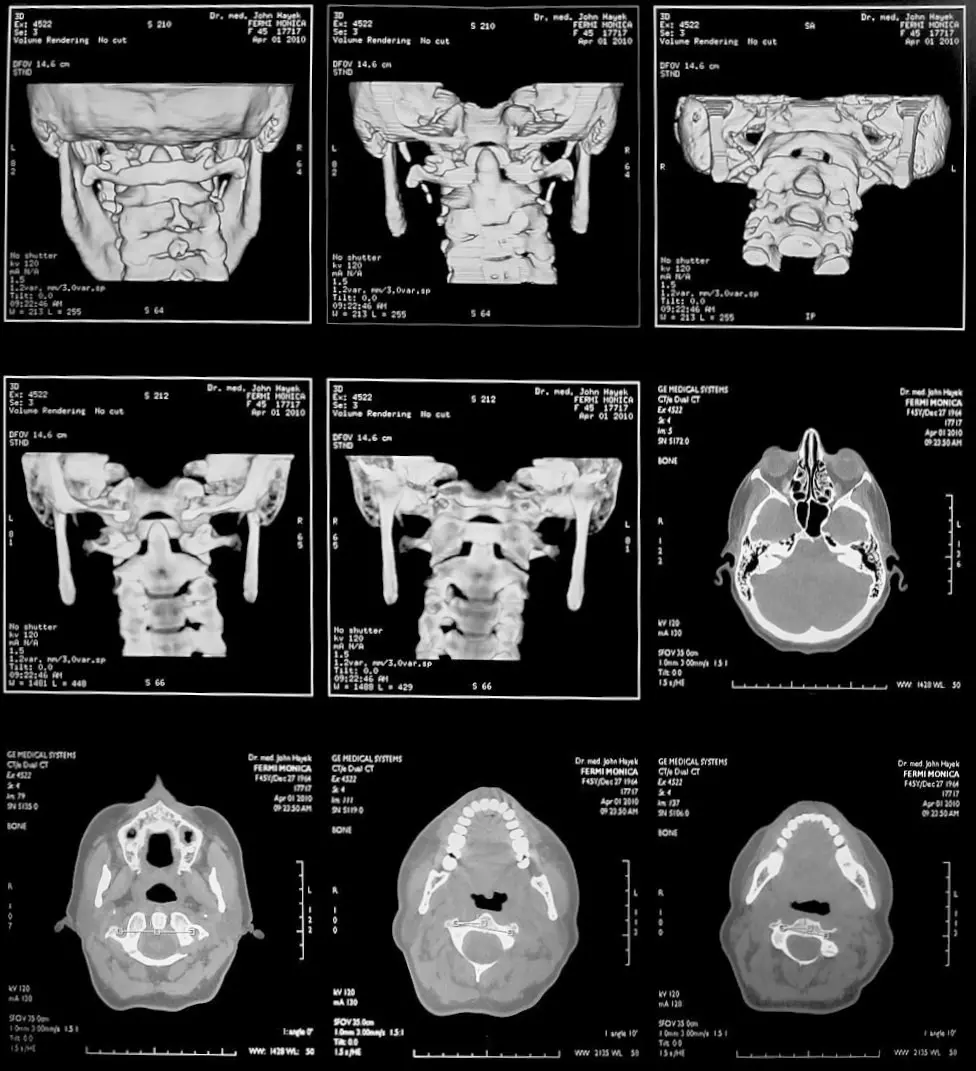Can the Atlas Become Misaligned Again?

The correction of the Atlas using Vibro-Resonance is usually performed only once and produces lasting results, unlike many other treatments that require regular repetitions. However, although rare, cases of recurrence cannot be completely ruled out, even after the AtlantoMed treatment.
Specific situations or events can occasionally cause the first cervical vertebra to return to its pre-treatment position or settle into an intermediate position.
By examining cases of recurrence, including through spiral CT scans, the following conditions have been identified:
- Particularly asymmetric Atlas or occipital condyles, either as a congenital condition or as a result of a difficult birth that deformed the skull. In addition, chronic cervical overloads with severe muscular tensions acting on chronically dysfunctional vertebrae can, over time, alter the bone structure (hence the importance of early intervention in childhood). In such circumstances, the Atlas tends to revert to its previous position, which may be more suitable and functional.
- Hyperlaxity of the atlanto-occipital ligaments: particularly the alar ligament, which may not provide sufficient stability to the joint and allow the Atlas to easily assume incorrect positions (see also cervical instability).
- Chronic unilateral cervical contractions, caused by excessive stress, persistent anxiety or fear, dental malocclusion and cranio-mandibular dysfunction, or other unidentified factors.
- Chiropractic/osteopathic cervical manipulations (thrust), with increased risk for individuals who have already suffered prior traumas.
- Intubation during surgery under general anesthesia. In these cases, the misalignment often involves underlying vertebrae as well, such as C2, C3, C4, and C5.
- New trauma with high-intensity impact, such as whiplash.
- Other factors not yet identified.
Understanding the Regeneration Phase
A phenomenon that must be well understood, to avoid unfounded fears, is the following: after the treatment, the so-called regeneration phase begins, during which reactions similar to old disorders or even different and seemingly inexplicable ones may appear and be misinterpreted. Moreover, old traumas may temporarily reactivate. If discomfort does not immediately disappear in the days following the treatment, this does not mean that the Atlas has become misaligned again. The self-regulation process can last several months. Reactions typically appear intermittently, and it is not uncommon for them to migrate to other areas of the body before resolving, often definitively. It is important not to confuse the regeneration phase with the effects of a new vertebral misalignment but to allow the body the necessary time to stabilize without undue alarm.
Will the Atlas shift back out of alignment easily?
Some people have the unfounded fear that the Atlas can easily slip out of place even with normal head movements. This belief generates stiffness and anxiety, negatively affecting cervical muscle tension. It can be reassuring to know that once corrected with the AtlantoMed method, the Atlas rarely becomes misaligned again. Just as it remained stuck in the wrong position for years, it tends to stay stable in the correct one. Everyday activities and common sports, as long as they are not violent or involve impacts, especially to the head, as in combat sports, do not alter the position of the Atlas. The same applies to the position adopted during sleep. In the weeks following the treatment, it is advisable to avoid excessive strain while maintaining a relaxed and worry-free attitude.
What to Do If You Think the Atlas Has Shifted Again?
There are some real and some imagined conditions that might lead you to believe that the Atlas has become misaligned again:
Self-Palpation
Before undergoing the AtlantoMed method, people are usually unaware of the existence of the Atlas vertebra. After the treatment, however, it is common to try locating it with fingers, attempting to feel something. This inevitably leads to incorrect conclusions, fueling unfounded doubts and worries, as recognizing the Atlas alignment on oneself is extremely difficult, even for a specialist. As explained in other sections, palpation by physiotherapists or osteopaths not specialized in the Atlas has a 50% margin of error. You can imagine how unreliable self-palpation might be. The Atlas should simply be left alone, avoiding unnecessary concerns and trusting the body's innate ability to self-regulate. Additionally, applying strong pressure with fingers on a recently corrected Atlas could influence its position.
Atlas Correction Does Not Make Us Immune to Muscle Contractures
Another commonly misunderstood aspect is this: correcting the Atlas does not make us immune to muscle contractures, which may reappear over time due to other factors still present, such as: dental malocclusion, unilateral body overload caused by physically demanding work, persistent anxiety and worry about the future, metabolic hyperacidosis, or a deficiency in minerals and micronutrients resulting from an unbalanced diet, intestinal dysbiosis, and more. For these or other reasons, muscle tensions may reappear regardless of the correct position of the vertebra, leading to the mistaken assumption of a new misalignment.
Keep in mind: the Atlas is a bone and, as such, does not cause pain. The pain comes from muscle tensions due to imbalances, combined with other negative effects that a misaligned vertebra can trigger throughout the body. These same effects may have other causes, which usually persist even after the correction, and their impact could be sufficient to cause new pain, independent of the Atlas. For this reason, as a matter of priority, it would be advisable to effectively address mandibular imbalance if it is present.
Unfortunately, many people fail to understand this necessity and, once the pain decreases, they feel so relieved that they neglect unresolved issues. If the pain reappears, they tend to erroneously attribute it again to the Atlas. Their flawed logic is: "With the Atlas correction, the pain disappeared; now that it has returned, it means my Atlas is misaligned again". In such cases, a massage session with AtlantoVib can relieve muscle tension; however, to achieve a definitive solution, it is necessary to identify and address the remaining contributing factors.
Actual New Misalignment
That said, there are indeed a few isolated cases where, due to the aforementioned reasons or other factors, a misalignment of the first cervical vertebrae occurs again after some time. Should this happen, the treatment can be repeated. I hope this explanation reassures you and helps you better understand your situation and whether the Atlas is truly responsible or not.
What to Do If AtlantoMed Does Not Produce the Expected Results?
It is well known that every coin has two sides. To ensure maximum transparency and the professionalism that distinguishes us, we believe it is appropriate to also mention the potential negative outcomes, avoiding false expectations and subsequent disappointments. In most cases, the AtlantoMed treatment is successful and without complications. However, in about 20% of cases, or 1 in 5, the expected results are not achieved. After the correction of the Atlas, there may be no improvements or even a perceived worsening, which is usually temporary.
Why Is the Atlas Correction Not Producing the Desired Effects?
The reasons for failure may include the following:
- The main one: the Atlas was not the root cause of the problem, which is why it was not resolved.
- The cervical spine and the body are in an advanced state of degeneration, making recovery impossible.
- There are other, more significant causes than the misaligned Atlas.
- Even the most experienced specialist can make errors.
Determining the position of the vertebrae using fingers as a tool is not easy, but it remains the most rational, least invasive, and most economical solution, even though it involves a small margin of error. To palpate the Atlas, several muscle layers must be navigated. The precision with which the Atlas specialist can determine the position of the vertebra depends on the state of tension in the cervical musculature and individual anatomical characteristics.
When the musculature is completely rigid and perhaps more developed or contracted on one side than the other, palpation may yield unreliable results. There are also cases where the muscle fibers have hardened to the point of feeling like bone. For this reason, palpation prior to correction is preceded by meticulous massage. The more relaxed the cervical musculature, the more precise the perception of vertebral positions will be. In addition to muscle tone, which can be addressed with massage, there remains the issue of musculature that is inevitably more developed on one side due to constant overload over a long period, a difference that persists regardless of reduced muscle tone. For these reasons, the possibility of evaluation errors by the therapist cannot be excluded.
How to Proceed?
If symptoms remain unchanged for a long time after correction, with no variations in intensity or location, the first step should be to have your Atlas checked again by the AtlantoMed specialist who performed the treatment or, if possible, to obtain a second independent opinion from another AtlantoMed specialist. This type of check only takes a few minutes and is free of charge.
Avoid Consulting Your Regular Therapist
Consulting your regular therapist for an additional check may not be advisable, as it could further increase your insecurities. Since you lack the objective tools to evaluate who is correct, adding an opinion with a 50/50 margin of error only creates more confusion. Trusting someone does not automatically mean that person is right.
When Is a CT Scan Indicated?
If the therapist confirms the correct alignment but the symptoms persist, it is very likely that the cause is not the Atlas, and in this case, the search should continue elsewhere. To exclude with absolute certainty the Atlas as the source of the discomfort or a potential error by the therapist, we recommend verification with a CT scan (spiral CT / cone beam CT).
This examination provides a clear view of what could not be precisely determined through manual palpation, eliminating any remaining doubts. However, it is not sensible to skip the proper sequence in an attempt to "play it safe" or save time. It is important to know that exposure to ionizing radiation can reduce life expectancy. Therefore, undergoing a CT scan without specific indications or real necessity is unwise, as it risks compromising future health.
If the misalignment is attributable to a therapist's error, a free corrective treatment will be provided. On the other hand, if the Atlas is in place but the symptoms persist, it becomes clear that there are other causes that need to be investigated, which, unfortunately, are unlikely to be discovered by visiting a doctor whose usual practice is to suppress symptoms without seeking their cause. Before proceeding further, it is important to calmly follow the necessary steps to definitively rule out the Atlas as the cause of the issue.
The worst thing to do is to get discouraged, give up, and rely on medication. It should also be noted that, although rare, there are cases of "deformed condyles" (mentioned in the first point of the list) where, despite all attempts, it is impossible to achieve optimal alignment due to the specific anatomical configuration. In such cases, the treatment places the vertebrae in the best possible position allowed by the specific anatomy, even if this may not be perfectly symmetrical. We hope to have provided a clear and complete overview of the possibilities.
What People Say About Us
Beware of those who disguise a simple cervical manipulation as Atlas realignment and those who offer low-quality imitations of our method. The results speak for themselves: over 10,000 testimonials and reviews in various languages make us unique. Click to discover opinions, ratings, and authentic experiences shared by those who have experienced Atlas correction with Vibro-Resonance AtlantoMed:




